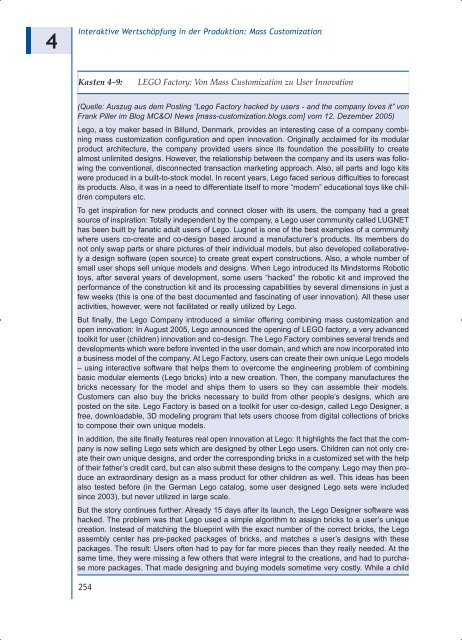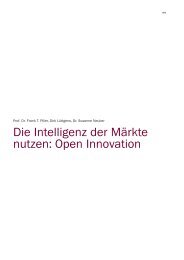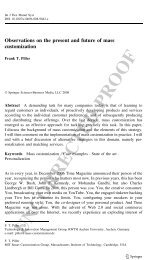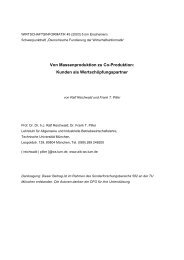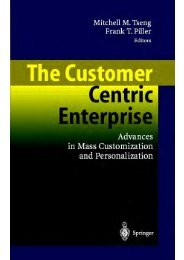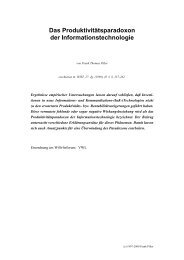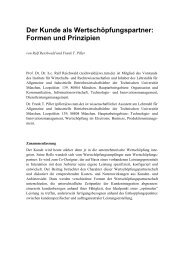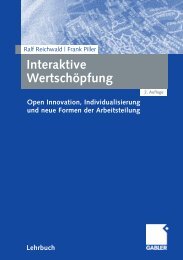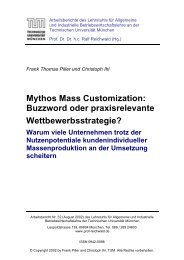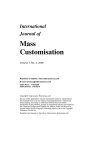Reichwald, Ralf / Piller, Frank
Reichwald, Ralf / Piller, Frank
Reichwald, Ralf / Piller, Frank
Erfolgreiche ePaper selbst erstellen
Machen Sie aus Ihren PDF Publikationen ein blätterbares Flipbook mit unserer einzigartigen Google optimierten e-Paper Software.
4<br />
Interaktive Wertschöpfung in der Produktion: Mass Customization<br />
Kasten 4–9: LEGO Factory: Von Mass Customization zu User Innovation<br />
(Quelle: Auszug aus dem Posting “Lego Factory hacked by users - and the company loves it” von<br />
<strong>Frank</strong> <strong>Piller</strong> im Blog MC&OI News [mass-customization.blogs.com] vom 12. Dezember 2005)<br />
Lego, a toy maker based in Billund, Denmark, provides an interesting case of a company combining<br />
mass customization configuration and open innovation. Originally acclaimed for its modular<br />
product architecture, the company provided users since its foundation the possibility to create<br />
almost unlimited designs. However, the relationship between the company and its users was following<br />
the conventional, disconnected transaction marketing approach. Also, all parts and logo kits<br />
were produced in a built-to-stock model. In recent years, Lego faced serious difficulties to forecast<br />
its products. Also, it was in a need to differentiate itself to more “modern” educational toys like children<br />
computers etc.<br />
To get inspiration for new products and connect closer with its users, the company had a great<br />
source of inspiration: Totally independent by the company, a Lego user community called LUGNET<br />
has been built by fanatic adult users of Lego. Lugnet is one of the best examples of a community<br />
where users co-create and co-design based around a manufacturer’s products. Its members do<br />
not only swap parts or share pictures of their individual models, but also developed collaboratively<br />
a design software (open source) to create great expert constructions. Also, a whole number of<br />
small user shops sell unique models and designs. When Lego introduced its Mindstorms Robotic<br />
toys, after several years of development, some users “hacked” the robotic kit and improved the<br />
performance of the construction kit and its processing capabilities by several dimensions in just a<br />
few weeks (this is one of the best documented and fascinating of user innovation). All these user<br />
activities, however, were not facilitated or really utilized by Lego.<br />
But finally, the Lego Company introduced a similar offering combining mass customization and<br />
open innovation: In August 2005, Lego announced the opening of LEGO factory, a very advanced<br />
toolkit for user (children) innovation and co-design. The Lego Factory combines several trends and<br />
developments which were before invented in the user domain, and which are now incorporated into<br />
a business model of the company. At Lego Factory, users can create their own unique Lego models<br />
– using interactive software that helps them to overcome the engineering problem of combining<br />
basic modular elements (Lego bricks) into a new creation. Then, the company manufactures the<br />
bricks necessary for the model and ships them to users so they can assemble their models.<br />
Customers can also buy the bricks necessary to build from other people’s designs, which are<br />
posted on the site. Lego Factory is based on a toolkit for user co-design, called Lego Designer, a<br />
free, downloadable, 3D modeling program that lets users choose from digital collections of bricks<br />
to compose their own unique models.<br />
In addition, the site finally features real open innovation at Lego: It highlights the fact that the company<br />
is now selling Lego sets which are designed by other Lego users. Children can not only create<br />
their own unique designs, and order the corresponding bricks in a customized set with the help<br />
of their father’s credit card, but can also submit these designs to the company. Lego may then produce<br />
an extraordinary design as a mass product for other children as well. This ideas has been<br />
also tested before (in the German Lego catalog, some user designed Lego sets were included<br />
since 2003), but never utilized in large scale.<br />
But the story continues further: Already 15 days after its launch, the Lego Designer software was<br />
hacked. The problem was that Lego used a simple algorithm to assign bricks to a user’s unique<br />
creation. Instead of matching the blueprint with the exact number of the correct bricks, the Lego<br />
assembly center has pre-packed packages of bricks, and matches a user’s designs with these<br />
packages. The result: Users often had to pay for far more pieces than they really needed. At the<br />
same time, they were missing a few others that were integral to the creations, and had to purchase<br />
more packages. That made designing and buying models sometime very costly. While a child<br />
254


